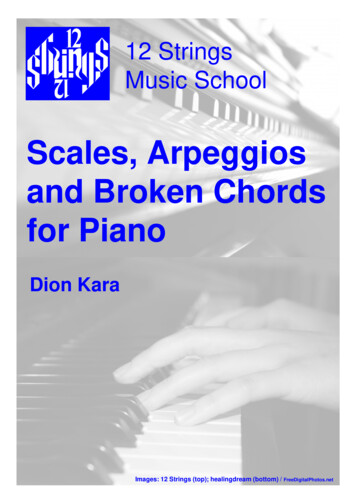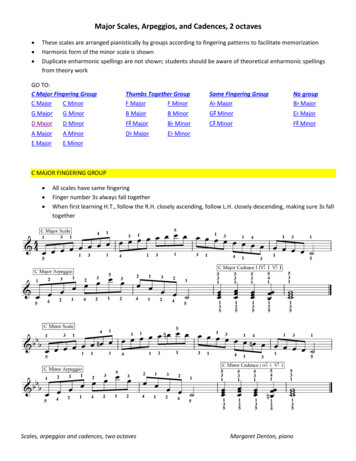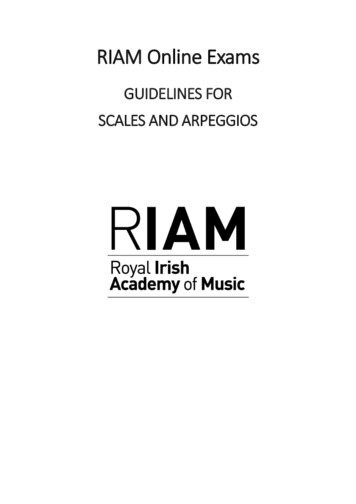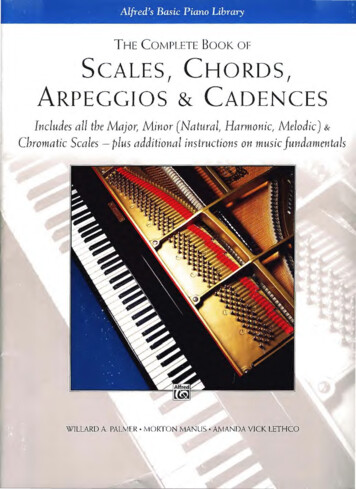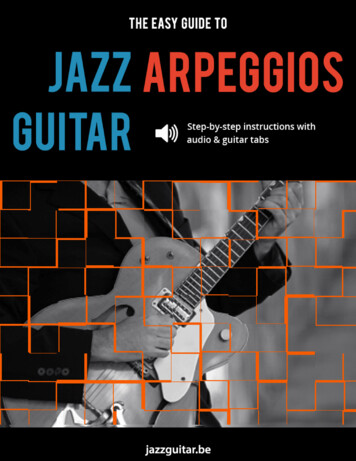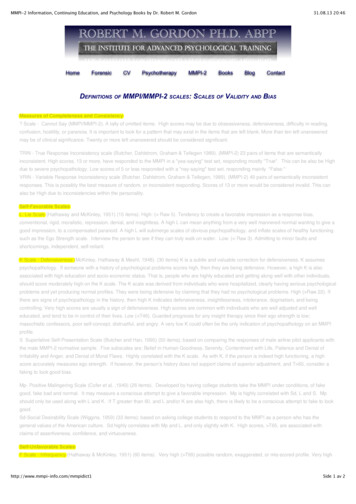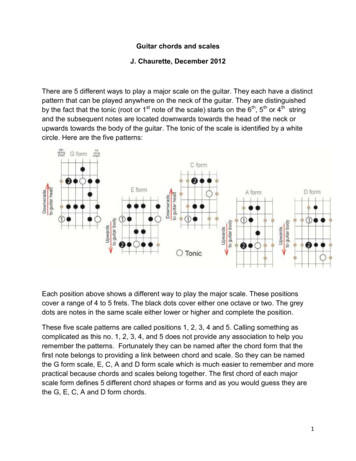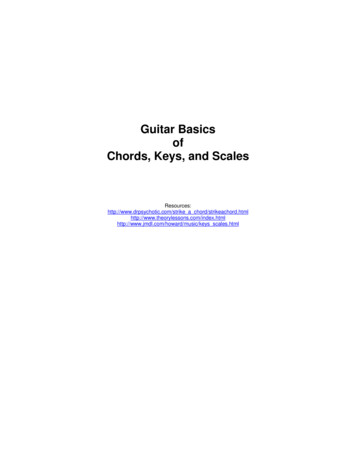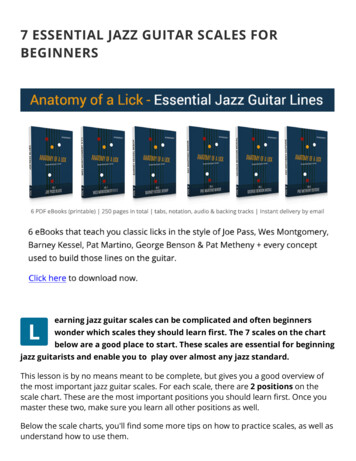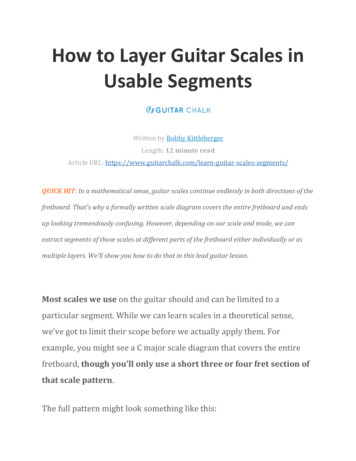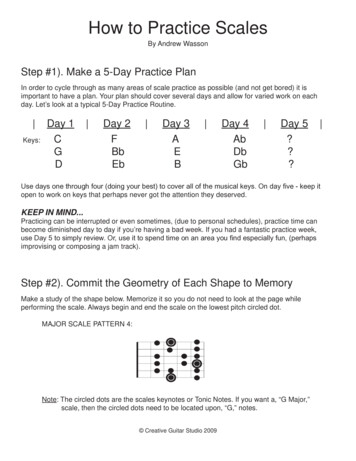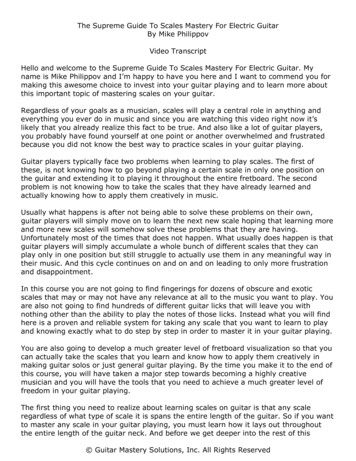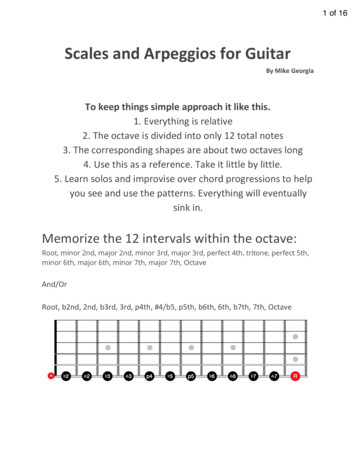
Transcription
1 of 16Scales and Arpeggios for GuitarBy Mike GeorgiaTo keep things simple approach it like this.1. Everything is relative2. The octave is divided into only 12 total notes3. The corresponding shapes are about two octaves long4. Use this as a reference. Take it little by little.5. Learn solos and improvise over chord progressions to helpyou see and use the patterns. Everything will eventuallysink in.Memorize the 12 intervals within the octave:Root, minor 2nd, major 2nd, minor 3rd, major 3rd, perfect 4th, tritone, perfect 5th,minor 6th, major 6th, minor 7th, major 7th, OctaveAnd/OrRoot, b2nd, 2nd, b3rd, 3rd, p4th, #4/b5, p5th, b6th, 6th, b7th, 7th, Octave
2 of 16LayoutAcross strings the notes either move “forward” up the neck,or back across the strings.When moving from string group to string group keep in mind:1. Since the B string is tuned one fret different from the other strings. The noteson the B and E strings move up one fret relative to the other strings.2. This changes the perceived shape of the pattern3. It also makes it so that you can comfortably move some notes to a differentstring than on other string sets.Mike Georgia
3 of 16b7 7Rp4b5p5b6 6Rb2 2b3 3b7 7Rp4b5p5b6 6Rb2 2b3 3b7 7Rp4b5p5b6 6Rb2 2b3 3 6b7 7R 3p4b5p5Rb2 2b3b6Mike Georgia
4 of 16ScalesIn general we can think of all scales as a derivative of themajor scale.1. The major scale uses one note from each letter of the musical alphabet.2. The major scale is easiest to see by looking at the white keys on the piano.3. The white keys with a black key in between are a whole step apart andthe ones without a black key in between are a half step. Creating thisMajor Scale formula: 1 w 2 w 3 h 4 w 5 w 6 w 7 h 1Here it is on the guitar:Mike Georgia
5 of 16Here are some common scale formulas.Majorw w h, w w w h1 w 2 w 3 h 4 w 5 w 6 w 7 h 1Minorw h w, w h w w1 w 2 h b3 w 4 w 5 h b6 w b7 w 1Harmonic Minorw h w, w h 1.5 h1 w 2 h b3 w 4 w 5 h b6 w h 7 h 1Melodic Minorw h w, w w w h1 w 2 h b3 w 4 w 5 w 6 w 7 h 1Pentatonic Majorw w 1.5, w 1.51 w 2 w 3 w h 5 w 6 w h 1Pentatonic Minor1.5 w w, 1.5 w1 w h b3 w 4 w 5 w h b7 w 1Blues Majorw h h 1.5, w 1.51 w 2 h b3 h 3 w h 5 w 6 w h 1Blues Minor1.5 w h h, 1.5 w1 w h b3 w 4 h b5 h 5 w h b7 w 1Diminished WHwh, wh, wh, wh1 w 2 h b3 w 4 h b5 w #5 h 6 w 7 h 1Diminished HWhw, hw, hw, hw1 h b2 w b3 h 3 w #4 h 5 w 6 h b7 w 1Whole Tonewww, wwwHarmonic Majorh 1.5 w, w w w hDouble Harmonic Majorh w h w, w h 1.5 h1 w 2 w 3 w #4 w #5 w b7 w 11 h b2 w h 3 w 4 w 5 w 6 w 7 h 11 h b2 w h 3 w 4 w 5 h b6 w h 7 h 1Mike Georgia
6 of 16ArpeggiosLet’s go over some chord construction. Chords are constructedby stacking every other note in the key like this:1 3 5 7 9 (2) 11 (4) 13(6)1. Basic major and minor chords are 1, 3, 5 then the notes are moved aroundto create different qualities of chords like: Major, Minor, Diminished, andAugmented2. When you add the 7th you then get chords like: Major 7, Dominant 7,Minor 7, Minor 7 (b5), Diminished 7, Major 7 (#5), Dominant 7 (#5)3. 2, 4, and 6 are called 9, 11, 13 when the 7th is present or Major7, Minor 7,Dom7, and Augmented chords can have the 9, 11, and 13 added to them.4. You can replace the 3 with the 2 or 4. This is called suspended or sus2,sus4.5. Adding the 2, but keeping the 3 is called add9.6. 6th chords are when you replace the 5 with the 67. Chords with 9, 11, 13 are called extended chords and the varieties are asfollows;b9, 9, #9 (when a major 3rd is present)11, #11b13, 13Mike Georgia
7 of 16Here are some common chord formulas.Major1 3 5Minor1 b3 5Diminished1 b3 b5Augmented1 3 #5Major 71 3 5 7Dominant 71 3 5 b7Minor 71 b3 5 b7Min 7 (b5)1 b3 b5 b7Dim 71 b3 b5 bb7Maj 7 aug1 3 #5 7Dom 7 aug1 3 #5 b7b9, #9, 11, #11, 13, b13Dom #9, b9, 11, #11, 13, b13Maj9, Maj7(#11), Maj13Maj 7 9, #11, 13Min7(b9), Min9, Min11, Min13Min 7 b9, 9, 11, 13Mike Georgia
8 of 16Major Scale ModesEach note in a scale can be considered the root. This is what themodes are. For instance if you start the major scale on the 6thnote you are playing the natural minor scale and the 3rd degreeof the minor scale is the major scale.1. It also helps to think of modes as major (3) or minor (b3), which dependson the third.2. Next notice how each mode has one or two notes that makes it uniquefrom the major or natural minor scale.3. Modes can also be thought of as chords scales. For instance Dorian is amin13 chord, Lydian is maj9(#11), Phrygian is min7(b9), Locrian ismin7(b5,b9)Ionian (maj7)w w h, w w w h1 w 2 w 3 h 4 w 5 w 6 w 7 h 1Dorian (min7)w h w, w w h w1 w 2 h b 3 w 4 w 5 w 6 h b 7 w 1Phrygian (min7)h w w, w h w w1 h b2 w b3 w 4 w 5 h b6 w b7 w 1Lydian (maj7)w w w, h w w h1 w 2 w 3 w # 4 h 5 w 6 w 7 w 1Mixolydian (dom7)w w h, w w h w1 w 2 w 3 h 4 w 5 w 6 h b7 w 1Aeolian (min7)w h w, w h w w1 w 2 h b3 w 4 w 5 h b6 w b7 w 1Locrian (min7)h w w, h w w w1 h b2 w b3 w 4 h b5 w b6 w b7 w 1Mike Georgia
9 of 16Harmonic Minor ModesThe harmonic minor scale is definitely an interesting one withits unique step and a half interval creating a very eastern soundto the western ear.1. Notice how the mode names are derivative of the major scale modes.2. A common use of harmonic minor is when there is a major V chord in aminor key. The major 3rd of the V chord is not in the natural minor scale,but it is the natural 7th in harmonic minor.3. Another use for harmonic minor that creeps up from time to time is the5th mode. With it’s Dom7 home chord and b2 it can be a very cool soundto incorporate.1 w 2 h b3 w 4 w 5 h b6 w h 7 h 1Harmonic Minorw h w, w h 1.5 hLocrian natural 6h w w, h 1.5 h w 1 h b2 w b3 w 4 h b5 w h 6 h b7 w 1Ionian #5w w h, 1.5 h w h 1 w 2 w 3 h 4 w h #5 h 6 w 7 h 1Dorian #4w h 1.5, h w h w 1 w 2 h b3 1.5 #4 h 5 w 6 h b7 w 1Phrygian Dominanth 1.5 h, w h w w 1 h b2 w h 3 h 4 w 5 h b6 w b7 w 1Lydian #21.5 h w, h w w h 1 w h #2 h 3 w # 4 h 5 w 6 w 7 h 1Superlocrian Dim.h w h, w w w1.51 h b2 w b3 h 3 w b5 w bb7 w w h1Mike Georgia
10 of 16Melodic Minor ModesThe melodic minor scale is closely related to the major scalewith its natural 6 and 7.1. In classical music the Melodic minor scale is played going up and thenatural minor scale is played going down.2. Super Locrian is often used in jazz over an Altered Dominant chord (b9,#9, b5, #5, #11, b13)Melodic Minorw h w, w w w h1 w 2 h b3 w 4 w 5 w 6 w 7 h 1Dorian b2h w w, w w h w1 h b2 w b3 w 4 w 5 w 6 h b7 w 1Lydian Augw w w, w h w h1 w 2 w 3 w #4 w #5 h 6 w 7 h 1Lydian Domw w w, h w h w1 w 2 w 3 w #4 h 5 w 6 h b7 w 1Mixolydian b6w w h, w h w w1 w 2 w 3 h 4 w 5 h b6 w b7 w 1Locrian natural 2w h w, h w w w1 w 2 h b3 w 4 h b5 w b6 w b7 w 1Super Locrian (Altered)h w h, w w w w1 h b2 w #2 h 3 w #4/b5 w #5/b6 w b7 w 1Mike Georgia
11 of 16Arpeggio and ScaleBox ShapesMike Georgia
12 of 16Mike Georgia
13 of 16Mike Georgia
14 of 16 Major Root Minor RootC/Am Shape A/Gm Shape Blues NoteG/Em Shape Scale TonesE/Dm Shape D/Cm ShapePentatonicBluesNaturalMajor/MinorPentatonic and Blues scale notes in Black, added Natural Major/Minor scale notes in greyNatural Major/Minor: Three note per string patternsLicensed under a creative commons BY, NC, ND license - mikegeorgia.comMike Georgia
15 of 16Harmonic MinorMelodic MinorLicensed under a creative commons BY, NC, ND license - mikegeorgia.comMike Georgia
16 of 16Whole ToneDiminishedLicensed under a creative commons BY, NC, ND license - mikegeorgia.comMike Georgia
Scales and Arpeggios for Guitar By Mike Georgia To keep things simple approach it like this. 1.Everything is relative 2.The octave is divided into only 12 total notes 3.The corresponding shapes are about two octaves long 4.Use this as a reference. Take it little by little.File Size: 1MBPage Count: 16
